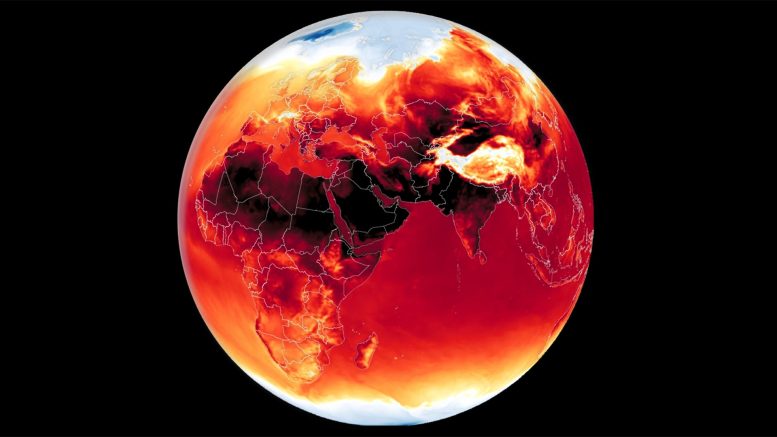
Record heat levels globally have led to significant health and infrastructure strains. Research advises both public system upgrades and personal safety measures to manage the rising temperatures.
Heat waves swept across parts of Europe, the Middle East, and South Asia, leaving vulnerable populations in jeopardy.
This year has seen unprecedented global heat records, causing widespread health emergencies and power challenges. Studies emphasize the dangers to vulnerable populations like the elderly and recommend systemic and individual actions to reduce heat exposure.
Record-Breaking Global Temperatures
It’s just the beginning of the summer season in the Northern Hemisphere, but Earth is already roasting.
Scientists from NASA’s Goddard Institute for Space Studies recently reported that May 2024, the hottest May in NASA’s global surface temperature analysis, marked a full year of record-high monthly temperatures. Likewise, NOAA recently reported that January through May 2024 ranked warmest on its 175-year temperature record. On June 19, 2024, the Northern Hemisphere was running 1.1 degrees Celsius (1.9 degrees Fahrenheit) above normal, according to an analysis of meteorological data from Climate Reanalyzer.
Impact of Early Summer Heatwaves
In this context, early summer heatwaves in the Northern Hemisphere have been fierce. Just as Central America and the southwestern and eastern United States saw blasts of heat in May and June, temperatures also soared in the Middle East, South Asia, and Africa. The series of heat waves has contributed to large numbers of deaths, strained power grids, and challenged meteorological records.
https://youtu.be/_OOAeA2UVA4
Record Heat Across Diverse Regions
The animation above shows the daily maximum surface air temperature across Northern Africa, the Middle East, and South Asia from June 15 to June 25, 2024. It was produced by combining satellite observations with temperatures predicted by a version of the Goddard Earth Observing System (GEOS) global model, which uses mathematical equations to represent physical processes in the atmosphere. The darkest red areas indicate temperatures of more than 40°C (104°F).
Extreme Heat and Public Health Challenges
According to news reports, nighttime temperatures were as high as 35.2°C (95.4°F) in Delhi on June 18, one of the hottest nights the city has seen in decades. In Greece, temperatures soared to 44.5°C (112.1°F) amid the closure of schools and historical sites. The Saudi National Center for Meteorology reported temperatures up to 49°C (120°F) in and around Mecca during Hajj.
In many cities, extreme temperatures collided with limited access to air conditioning, large outdoor events, high nighttime temperatures, a lack of green space, urban heat islands, and other factors to leave millions of people in hot and often humid conditions. The circumstances triggered not just discomfort but heat exhaustion and heatstroke in some places. The annual Hajj pilgrimage to Mecca in Saudi Arabia proved particularly deadly in mid-June, but news reports indicate that the heat was associated with hospitalizations and deaths in India, Pakistan, Egypt, and Greece as well.
Strategies and Recommendations for Heat Preparedness
According to the World Health Organization, heat stress is the world’s leading cause of weather-related deaths and can exacerbate underlying illnesses including cardiovascular disease, diabetes, mental health conditions, and asthma. Researchers have calculated that roughly 489,000 heat-related deaths occur each year, with 45 percent of the deaths in Asia and 36 percent in Europe.
“For older adults with physical health problems, temperatures as low as 26.7°C (80°F) can pose significant danger. And when humidity is as high as 90 percent, even 25.6°C (78°F) can be hazardous,” said Deborah Carr, a Boston University sociologist who specializes in the study of aging. “Nighttime heat is especially harmful for older adults whose homes lack air conditioning or who can’t afford to run their air conditioners for long periods.”
Future Risks and Preventative Measures
Carr is part of a research team that used temperature and climate data archived by NASA and demographic data to identify which parts of the world are at the greatest risk of current and future heat exposure. They published their results in Nature Communications in May 2024. They found that, in 2020, about 14 percent of the world’s population 69 years of age or older resided in areas where the average maximum temperature exceeded 37.5°C (99.5°F)—the level at which even brief exposure can be dangerous for older adults. The researchers projected that by 2050, more than 23 percent of that age group will face maximum temperatures that exceed 37.5°C—an increase of around 200 million older adults.
Public and Personal Strategies for Heat Adaptation
To prepare, Giacomo Falchetta, one of the authors of the study and a researcher at the Euro-Mediterranean Center on Climate Change, recommended a number of tailored public approaches. Well-resourced cities might increase investments in early warning systems and ride services to cooling centers and hospitals. By using remote sensing and geographic information systems, public officials could identify neighborhoods with high levels of heat exposure, and expand power grids to manage the increasing demand for air conditioning, he said. In contrast, improving access to high-quality housing, air conditioning, and clean water could have the greatest impact in cities with fewer resources, he added.
There are steps individuals can take to minimize risks as well. “The number one thing that older adults need to recognize is that they’re not the same person they were 50 years ago,” said Carr. “Biological changes mean that we can’t tolerate heat as well in our older years. Stay indoors during heat waves. If you have to go outside, get your activities done in the early morning or evening, when temperatures cool down. Drink plenty of water. Don’t use the oven, especially in small homes. Be sensitive to symptoms like dizziness and call for medical attention.”
NASA Earth Observatory video by Lauren Dauphin, using GEOS data from the Global Modeling and Assimilation Office at NASA GSFC.









“According to the World Health Organization, heat stress is the world’s leading cause of weather-related deaths and can exacerbate underlying illnesses …”
Not all sources agree with that claim:
https://www.forbes.com/sites/joshuacohen/2023/07/19/excessive-summer-heat-can-kill-but-extreme-cold-causes-more-fatalities/
Citing ‘… The Lancet Planetary Health, cold is far more deadly. For every death linked to heat, nine are connected to cold.”
One might ask if we are being ‘gas lighted’ to advance a political agenda.
This gaslighting has been going on for decades.
In a nutshell, if the left believes it, I don’t.